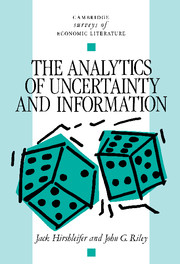Book contents
1 - Elements of decision under uncertainty
Published online by Cambridge University Press: 05 June 2012
Summary
Every individual must choose among acts – or synonymously, he or she must make decisions, or select among actions, options, or moves. And, where there is uncertainty, Nature may be said to “choose” the state of the world (or state, for short). You decide whether or not to carry an umbrella; Nature “decides” on rain or sunshine. Table 1.1 pictures an especially simple 2 × 2 situation. Your alternative acts x = (1,2) are shown along the left margin, and Nature's alternative states s = (1,2) across the top. The body of the table shows the consequences cxs resulting from your choice of act x and Nature's choice of state s.
More generally the individual under uncertainty will, according to this analysis, specify the following elements of his decision problem:
(1) a set of acts (1, …, x, …, X) available to him;
(2) a set of states (1, …, s, …, S) available to Nature;
(3) a consequence function c(x, s) showing outcomes under all combinations of acts and states.
And, in addition:
(4) a probability function π(s) expressing his beliefs (as to the likelihood of Nature choosing each and every state);
(5) an elementary-utility function (or preference-scaling function) ν(c) measuring the desirability of the different possible consequences to him.
We will explain below how the “Expected-utility Rule” integrates all these elements so as to enable the individual to decide upon the most advantageous action.
- Type
- Chapter
- Information
- The Analytics of Uncertainty and Information , pp. 7 - 42Publisher: Cambridge University PressPrint publication year: 1992



